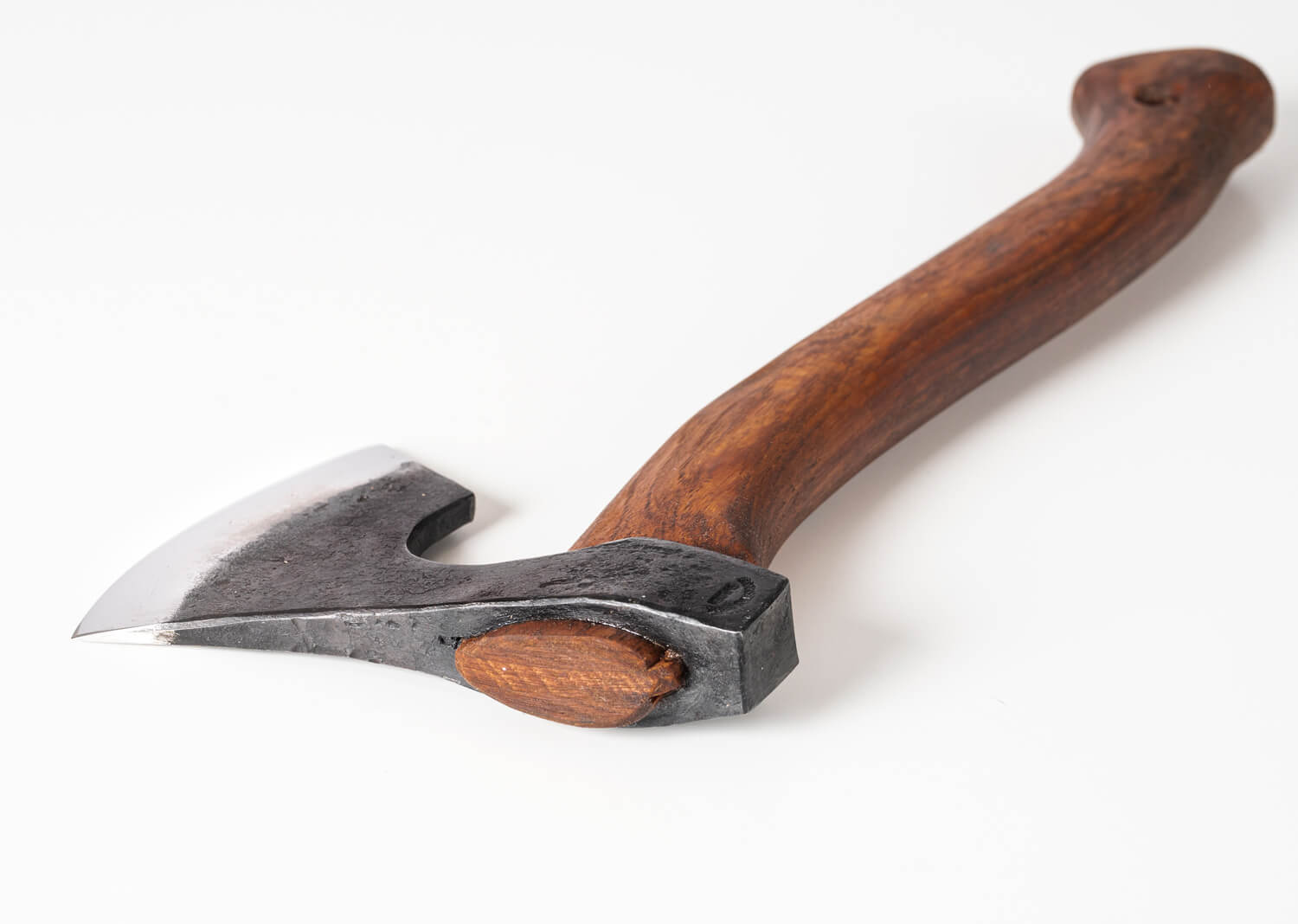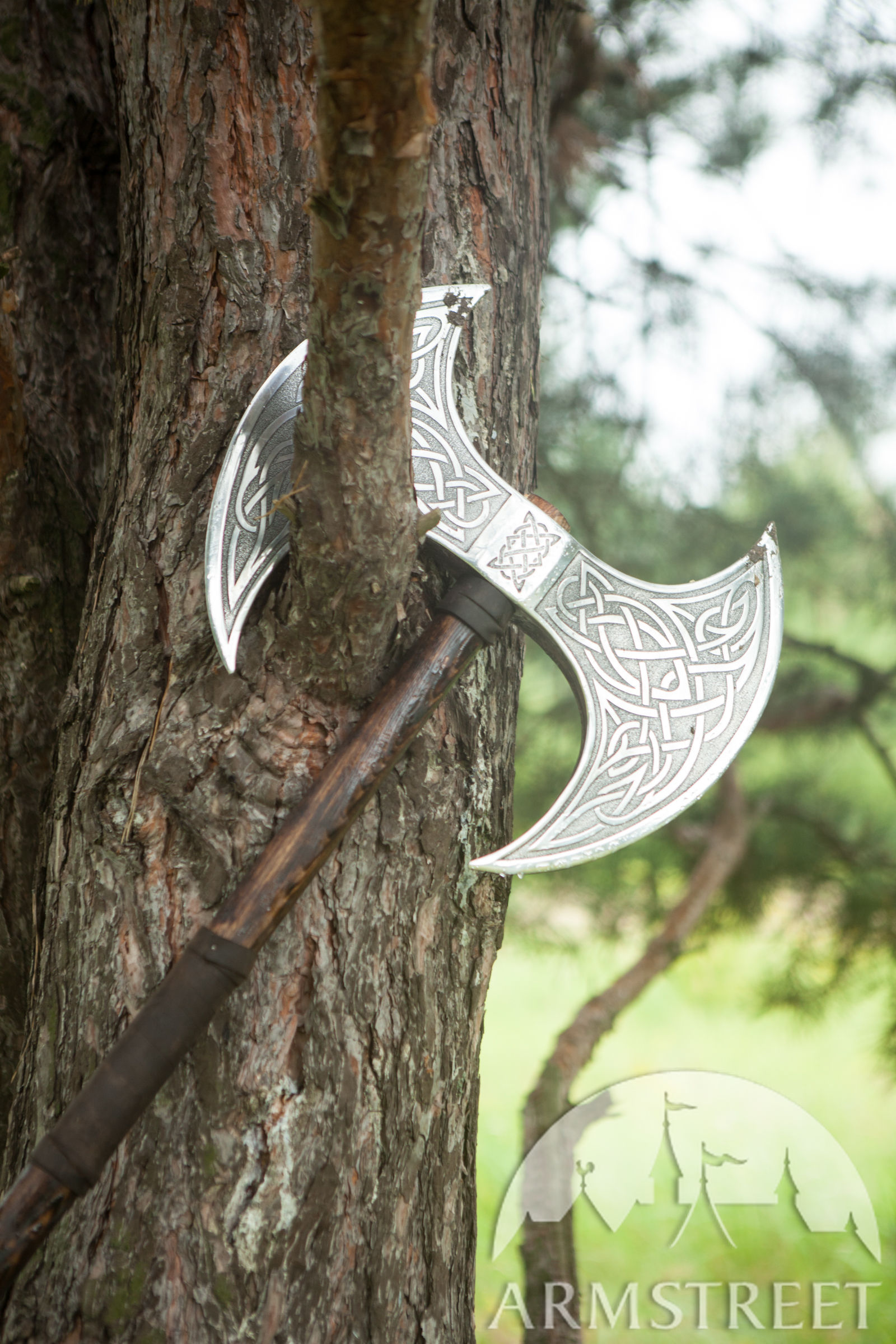From a recent e-mail :
I'm looking to get a labry made, obviously custom, as a female I'm looking for something made for full functionality and usability to last for as long as time would allow, eventually to be passed down to my grandsons ... can you give me an estimate of what I'm looking to be spending.? (1)
I had to look up 'labrys' : https://en.wikipedia.org/wiki/Labrys
 |
| Golden minoan labrys ( double ax ) Archaeological Museum in Herakleion. (2) |
Although you do always have to be careful with the short hand of Wikipedia, the article does match pretty much what I did know generally about double bladed axes in archaeology. Mainly that these rarely existed as objects, and when they did, they were certainly ritual / religious symbols rather than functioning weapons. There are existing (ancient) depictions of the labrys, but these are initially related to goddess figures (so the proportions are clearly unrealistic).
Modern fantasy artists (blame Frank Frazetta) have often included axes of various kinds - but again there is little realism in the sizes seen.
 |
| 'The Snow Giants' Frazetta - 1967 |
There is an aspect of physical dynamics involved in the 'real' over the
'fantastic'. Even with a long double hand handle, any axe much over 2 kg
just can not be controlled in movement. This is certainly proven if you
look to Viking Age axes, a time period (particularly from Denmark) when
axes became commonly used in combat. Or to lumbering tools from the
Canadian Settlement period.
(see a blog commentary related to a different artifact axe)
So one clear decision point for anyone will be to determine if they are
desiring what is more a symbolic than a functional object.
(In this case, 'Full functionality' may present a bit of an interpretation problem.)
I usually suggest people take a comparison look at the line of axes made by
Gransfors Bruk of Sweden. This company has a long history of forging
high quality tool axes. (3) They do make an extremely high
quality product, typically mild steel bodies with inlaid carbon steel
cutting edges. (I have one of their 'forest axes' myself - and it is an
excellent tool.)
 |
| the Gransfors Double Bit Axe |
Functional double bit axes were common in the 1800's in North America as
a standard logging tool. The two edges had slightly different bevel angles,
allowing for use for both felling and splitting. You can see G/B offers
one, in modern times more commonly used for competition axe throwing
(which has been popular the last decade).
You can see the important details :
- head weight = 2 kg
- blade length = 16 cm
- cost = $480 CDN (plus shipping, any duty)
In actual fact, the closest comparisons available at G/B will be found on their
(limited) 'Ancient' line
- replicas of Viking Age working tool axes.
You can see two examples there, the bearded axe and the (smaller) double lug axe.
 |
| Gransfors Double Lug Axe, showing slit eye construction |
From the descriptions, the bearded axe is likely the closest to ideal -
as these are individually hand forged - and specifically mention an
inset carbon steel edge
- head weight = 1.3 kg
- blade length = (not given, but likely in the range of 15 cm)
- cost = $1450 CDN (plus shipping, any duty)
 |
| Gransfors Bearded Axe, showing punched eye construction |
So - this is the 'standard' for a roughly similar type. Creating a
double edge (over a shaped then punched eye, single edge) represents
both a different method - and certainly additional work / time (two
inset edges to weld and shape).
A rough ball park quote for this specific request (Labrys type) is hard to generate, because exact details on
size have not been established.
But *expect in the range of $1500 - $2000 CDN* (plus required HST, shipping)
Now I will warn you that I am certain there are certainly 'wall hanger'
versions available - what are basically nothing more than costume
pieces. At *best* cast steel heads, if even a size to be realistic in
handling. (More likely cast aluminum for wide edges / large heads like
seen in films). These things are not actual working tools (despite what
may be claimed). If your interest is the visual / ritual aspect, those
may suit?
Source: https://armstreet.com/store/armoury/fantasy-viking-double-head-axe
 |
| 'Fantasy Viking Double-Headed Axe' : Hollow stainless sheet, 40 x 33 cm (4) |
I would caution you to really look closely at the description and especially the construction details of cheap (mass produced!) products offered. (Taking two pieces of cut out mild steel, then MIG welding these to a section of pipe, may be fine for a Halloween costume - but this is not 'real' in any stretch of the imagination.)
| 'Labrys Double Headed Axe' : Cut sheet welded to pipe |
Readers who wish to read further commentaries about past axe making projects by the Wareham Forge will find any number here on this blog :
Norse Woodworking Axes
VA Ship Tools - Adze & Broadaxe
French Trade Axe from Bloom Iron
Ship Tools - Adze / Broadaxe
Images are direct links from the indicated web sites
1) Intentionally hiding the original sender. I do warn people, with a tag line at the bottom of any e-mail, that : " To those receiving long detailed replies to specific questions : My own written response may be edited and re-used as a blog posting. "
2)
3) I would dispute their definition of their
main line of products as 'hand' forged, in fact they have designed (and long used)
specialized mechanical hammers and dies. This is a massive investment,
but also allows them to fairly quickly produce standardized shapes (with
little to no actual hand hammering). (see their web site description ) Note that this does not apply to the 'Ancient Line' discussed later here. Those are individually worked by hand hammering.
4) This object is described as " Forged out of genuine stainless steel ..."
Increasingly the technical term 'forged' is being used to mean 'made'. This is absolutely incorrect - and I consider the worst kind of commercial hype. As the Webster Dictionary also defines 'forged' as : "made falsely especially with intent to deceive" - you do have to wonder!








No comments:
Post a Comment